The Ten Oxherding pictures
Rerevend Eshin
The Ten Oxherding pictures are an early teaching in the Ch'an/Zen tradition. Oxherding was a useful metaphor for training the mind. There is the story of a monk working in the kitchen when his master came in and asked what he was doing. He replied 'Just herding the ox'.
The master responded 'How are you herding it?'.
The monk replied 'Every time the ox tries to wander off the way to eat grass, I rein it in and put it back to work'.
The ox, of course, is our mind. It must be trained not to wander off into distracting, discursive thoughts. It must be trained to align with the Dharma and so become pure.
Many versions of the oxherding pictures were created. They varied in number and in the content of the pictures. Eventually ten pictures or stages were developed. The most famous set is by K'uo-an Shih-yuan. Many artists have drawn these pictures and many poets have added commentaries. Below is just one example -
1. The Search for the Ox
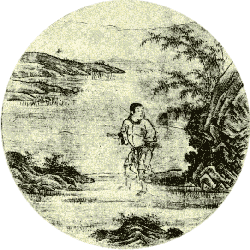
In the pasture of the world,
I endlessly push aside the tall
grasses in search of the Ox.
Following unnamed rivers,
lost upon the interpenetrating
paths of distant mountains,
My strength failing and my vitality
exhausted, I cannot find the Ox.
I only hear the locusts chirping
through the forest at night.
Humans are different from animals in that they can think and reflect. It is our thinking and reflecting that brings us to wonder or question about ourselves and life. Some people seek a reason for life, they seek the ox. At first they seek outside of themselves, looking at philosophy, science, occult matters, etc. Perhaps wealth and personal possessions have been amassed to cover the aches and discomforts of the heart and mind, and now the person wearies of this, it no longer works.
2. Discovering the Footprints
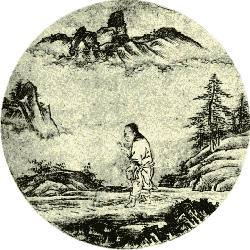
Along the riverbank under the trees,
I discover footprints.
Even under the fragrant grass,
I see his prints.
Deep in remote mountains
they are found.
These traces can no more be
hidden
than one's nose, looking
heavenward
Eventually the sincere seeker discovers that what must be investigated is the mind itself. Perhaps the seeker has fortunate karma ripening, coming into contact with the Buddha Dharma. It is when we stop looking to external things to save or liberate us.
3. Perceiving the Ox
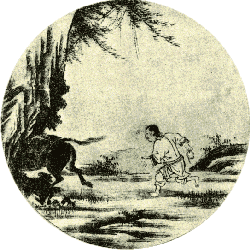
I hear the song of the nightingale.
The sun is warm, the wind is mild,
willows are green along the shore -
Here no Ox can hide!
What artist can draw that massive
head,
those majestic horns?
Here the person sees the tail of the ox. There is the realization that one has found the true path for salvation and liberation. What a relief it is! The world can seem a much sweeter place. However, the ox has not yet been grasped.
4. Catching the Ox
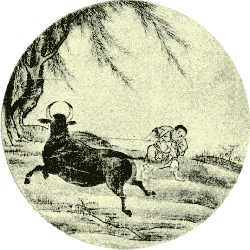
I seize him with a terrific struggle.
His great will and power
are inexhaustible.
He charges to the high plateau
far above the cloud-mists,
Or in an impenetrable ravine he stands.
At this stage the person has engaged in their Buddhist practice. Here the mind is apparent most of the time. No longer is the person lost in delusion, being not even aware of how they really are. For the first time the undisciplined activities of the mind are addressed. At first it seems so difficult with old, habitual patterns of thought rising up and overwhelming us. Sometimes our mind runs wild. Sometimes it is stuck, not moving with circumstances.
5. Taming the Ox
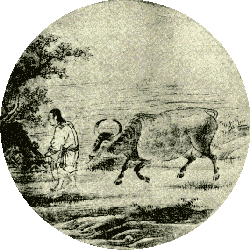
The whip and rope are necessary,
Else he might stray off down
some dusty road.
Being well-trained, he becomes
naturally gentle.
Then, unfettered, he obeys his
master.
Here Buddhist practice continues diligently. Many means of help are used. These can be meditation, mantras, temple services, chanting, sila (precepts), etc. They can also be the kinship of fellow Buddhist practitioners, guides and teachers.
As the negativities of the mind are quieted it is possible to practise self-cultivation in one's ordinary life. Here one is not fully overwhelmed by the habitual, negative aspects of the mind. It has become clear what Buddhist practice is.
6. Riding the Ox Home
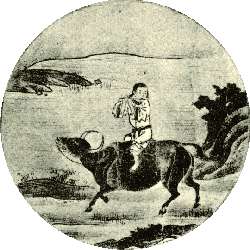
Mounting the Ox, slowly
I return homeward.
The voice of my flute intones
through the evening.
Measuring with hand-beats
the pulsating harmony,
I direct the endless rhythm.
Whoever hears this melody
will join me.
Here the oxherder is playing a flute while riding the ox. The ox still has its nose-ring and rope. But now the oxherder no longer has to hold the rope and pull the ox back to the way. Buddhist practice and self-cultivation have become a natural activity. The sense organs are purified, meaning that the person is aware of the environment but does not generate feelings of greed, anger or lust from the contact with outer things.
7. The Ox Transcended
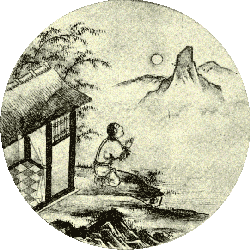
Astride the Ox, I reach home.
I am serene. The Ox too can rest.
The dawn has come. In blissful repose,
Within my thatched dwelling
I have abandoned the whip and ropes
In the beginning stages it is like swimming upstream. Hard, diligent practice is needed to make headway against the current of the mind. Here there is no need for the swimmer. The swimmer and the water have become one. Practice is no longer done for a goal, to get somewhere. Life itself is practice.
8. Both Ox and Self Transcended
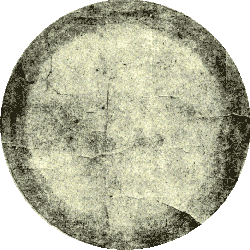
Whip, rope, person, and Ox -
all merge in No Thing.
This heaven is so vast,
no message can stain it.
How may a snowflake exist
in a raging fire.
Here are the footprints of
the Ancestors.
In the eighth picture there is no ox and no person. Is a fish aware of the water it swims in? When there is a subject, looking out, then there is an object. When there is an object then there is a subject to know it. If there is one then there must be two. One is only in comparison to something.
This is the stage beyond all dualities, of no inside, no outside; no subject and object; no person and environment. It is said there is no words to describe this stage. How can you grasp yourself, is it by pointing at your face and saying this is me, or by describing ourselves? When we are truly ourselves we would be able to separate from ourselves. When one has become one with self-nature there is no longer self-nature.
9. Reaching the Source
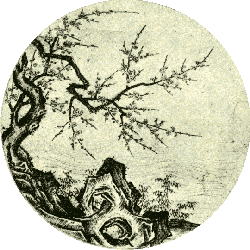
Too many steps have been taken
returning to the root and the source.
Better to have been blind and deaf
from the beginning!
Dwelling in one's true abode,
unconcerned with and without -
The river flows tranquilly on
and the flowers are red.
There is a famous Ch'an/Zen saying that in the beginning mountains are mountains and rivers are rivers. Then, at a particular point in practise, represented by the eighth picture, mountains are no longer mountains and rivers are no longer rivers. After this mountains truly are mountains and rivers truly are rivers.
This stage is to know the world in its true nature. Rivers flow and a flower is red. There is no more self-consciousness reactions to distort the world.
10. In the World
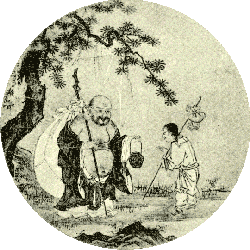
Barefooted and naked of breast,
I mingle with the people of the world.
My clothes are ragged and dust-laden,
and I am ever blissful.
I use no magic to extend my life;
Now, before me, the dead trees
become alive.
Here is an enlightened person. Bare of self adornments and pretensions. There is only the wholesome outflowings of an enlightened mind.
The dead trees become alive refers to two things
1. There is a Ch'an/Zen saying 'The flower blossoms on the withered branch'. It means that when our negativities have completely withered then our Buddha-nature blossoms, and
2. It is the activity of the enlightened person to awaken the unenlightened.

